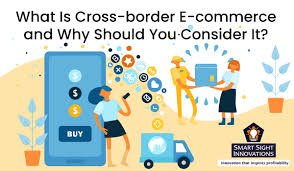The global e-commerce market continues to surge, projected to expand from $5.13 trillion in 2022 to more than $8.09 trillion by 2028. With this growth comes a sharp rise in cross-border shopping, where consumers buy from retailers outside their home countries. In fact, studies show that 52% of U.S. and U.K. shoppers have already made cross-border purchases, a trend accelerating worldwide.
To meet the demands of this new digital economy, e-commerce businesses are turning to AI, automation, and personalization. These technologies are not just buzzwords—they are the core enablers of efficient logistics, smarter pricing, stronger security, and more relevant customer experiences.

AI in Cross-Border E-Commerce
Artificial Intelligence (AI) is shaping the way companies expand into global markets by making platforms more accessible, secure, and predictive.
1. AI for Accessibility
AI-powered translation tools allow e-commerce platforms to instantly localize websites, enabling customers around the world to browse in their native language with clear and accurate product descriptions.
2. AI for Security & Fraud Prevention
With online payment fraud predicted to hit $362 billion globally between 2023 and 2028 (Juniper Research), AI-driven fraud detection is essential. These systems learn to recognize suspicious transactions in real time, protecting both companies and customers.
3. AI for Dynamic Pricing
AI helps businesses adjust product prices in real time based on region, demand trends, and competitor activity. For example, global fashion brands now use AI-driven pricing engines to remain competitive in multiple regions simultaneously.
4. Predictive Shopping Trends
By analyzing consumer behavior across geographies, AI forecasts when certain regions are likely to buy specific products. This empowers brands to prepare inventory and marketing campaigns in advance.

Automation: The Backbone of Efficiency
For cross-border e-commerce, automation is a game-changer in logistics, compliance, and customer service.
- Warehousing & Logistics: Automation optimizes inventory management, courier selection, and real-time package tracking.
- Customs Compliance: Automated tools handle paperwork and compliance with import/export regulations, helping avoid fines and reducing delivery delays.
- Returns Management: Automated systems simplify international returns, improving customer trust.
- Customer Service Chatbots: AI chatbots provide instant answers to common questions 24/7 while seamlessly escalating complex issues to human agents.
Example: Amazon’s automated fulfillment centers use robotics and AI to handle millions of international orders daily, minimizing costs and maximizing speed.
Personalization: Building Relationships Across Borders
Personalization is no longer a “nice-to-have”—it’s a necessity for global brands.
- Localized Shopping Experiences: Personalized product recommendations based on browsing history, location, and cultural context.
- Relevant Payment Options: In many regions, consumers prefer local e-wallets. Offering multiple payment providers builds trust and boosts conversions.
- UX Enhancements: Tailored messages, promotions, and shopping journeys create a sense of familiarity for international customers.
Example: Netflix’s international success relies on hyper-localized recommendations and regionalized subscription plans, a playbook e-commerce businesses can replicate.

Challenges in Implementation
While the benefits are clear, adopting AI and automation comes with hurdles:
- Data Security & Compliance: Businesses must adhere to global data protection standards (like GDPR) to protect customers.
- Integration Costs: Auditing current systems helps identify where AI and automation can be deployed without major disruption.
- Employee Upskilling: Staff must be trained and kept updated with new AI-driven tools.
- Choosing the Right Tools & Partners: Companies must evaluate solutions that fit their workflows while ensuring strong vendor support.
The Road Ahead
For e-commerce companies, AI and automation represent a roadmap to sustainable growth. These tools save time, cut costs, improve security, and strengthen global customer relationships. However, businesses must implement them strategically—balancing technology with a human touch.
Companies that adopt AI for personalization and automation for logistics will not only capture global market share but also build trust and loyalty across borders.
The future of cross-border e-commerce belongs to those who can leverage technology while staying customer-centric.






